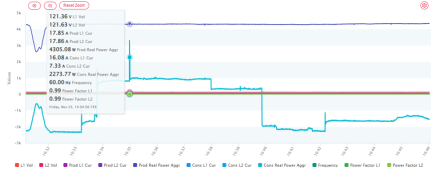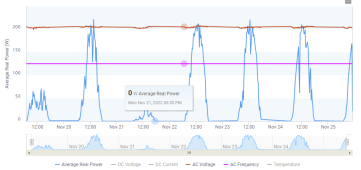I recently had a 10 kW grid-tied solar system bid by a local electrical company that also specializes in solar. I live at:
48.5126° N, 122.6127° W and they specified the following system:
25 400W panels with micro-inverters:
Silfab 400HC+
Enphase IQ7+
I'm far from being a solar expert but I asked about the potential for clipping with micro-inverters rated at 295W with 400W panels. The person who specified the system said if I wanted less clipping and didn't mind spending more, I could go with Enphase IQ8H for about $100 more per micro-inverter. When I looked at the specs I noticed the latter had a higher minimum voltage. I don't know if that will limit my production under heavy cloud cover or not. How do I weigh the clipping potential during optimum conditions against the minimum voltage (which I assume might limit my production at the low-light threshold? I'm simply not confident enough that the person spec'ing the system knows the details well enough to get a solid answer.
I'm not really doing this to save money (although it will in the long run). I am more interested in helping the grid use less energy from traditional sources so low-light production early and late in the day and in the winter is a bit more important to me than peak generation or total annual production. I'm a firm believer that the current rules around net metering (at least in Washington State) are not necessarily incentivizing solar panel installs tailored to the most beneficial production. I'm glad solar is being incentivized, but I think it's important to incentivize morning, evening and winter production so we don't end up with such a huge surplus of mid-day energy while neglecting first light, late afternoon and winter production.
The town I live in is in the rain shadow of the Olympic Mountains so it's actually considerably sunnier here than even 15-20 miles away and it has a strong influence from the marine breezes that will help peak production during warm weather. I doubt this is taken into account in the models used to specify solar systems because it's a very local effect. In short, it's brighter and cooler here.
I realize no one can design an ideal system without more information than what I have provided, but I'm looking for feedback on how these particular panels mated to the two micro-inverters listed (or any other Enphase options that might improve the system). The panels themselves are manufactured locally but they are a new model, so we only have the brand name and the specs to go on.
TIA for any informed feedback about any of the mentioned aspects.
48.5126° N, 122.6127° W and they specified the following system:
25 400W panels with micro-inverters:
Silfab 400HC+
Enphase IQ7+
I'm far from being a solar expert but I asked about the potential for clipping with micro-inverters rated at 295W with 400W panels. The person who specified the system said if I wanted less clipping and didn't mind spending more, I could go with Enphase IQ8H for about $100 more per micro-inverter. When I looked at the specs I noticed the latter had a higher minimum voltage. I don't know if that will limit my production under heavy cloud cover or not. How do I weigh the clipping potential during optimum conditions against the minimum voltage (which I assume might limit my production at the low-light threshold? I'm simply not confident enough that the person spec'ing the system knows the details well enough to get a solid answer.
I'm not really doing this to save money (although it will in the long run). I am more interested in helping the grid use less energy from traditional sources so low-light production early and late in the day and in the winter is a bit more important to me than peak generation or total annual production. I'm a firm believer that the current rules around net metering (at least in Washington State) are not necessarily incentivizing solar panel installs tailored to the most beneficial production. I'm glad solar is being incentivized, but I think it's important to incentivize morning, evening and winter production so we don't end up with such a huge surplus of mid-day energy while neglecting first light, late afternoon and winter production.
The town I live in is in the rain shadow of the Olympic Mountains so it's actually considerably sunnier here than even 15-20 miles away and it has a strong influence from the marine breezes that will help peak production during warm weather. I doubt this is taken into account in the models used to specify solar systems because it's a very local effect. In short, it's brighter and cooler here.
I realize no one can design an ideal system without more information than what I have provided, but I'm looking for feedback on how these particular panels mated to the two micro-inverters listed (or any other Enphase options that might improve the system). The panels themselves are manufactured locally but they are a new model, so we only have the brand name and the specs to go on.
TIA for any informed feedback about any of the mentioned aspects.




